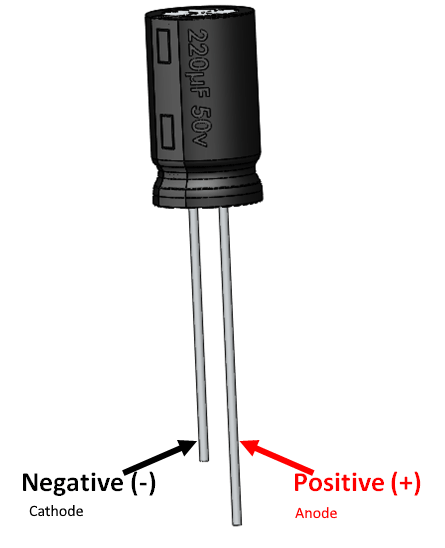Electrolytic Capacitors

On these electrolytic capacitors, there's a positive pin, called the anode, and a negative pin called the cathode. The anode always needs to be connected to a higher voltage. If you wire it up the other way around with the cathode getting a higher voltage, then prepare for an exploding cap!
The Electrolytic Capacitors have polarity. Meaning they have a positive and negative pin. The pin which is long is the positive pin and the pin which is short is the negative pin. You can also identify the polarity using the negative strip on the capacitor label. As shown in the picture above the negative pin will be directly under the negative symbol.
Capacitor Parameters Selection
Ever wondered about the types of Electrolytic capacitors available in market and how to select one for your project? Electrolytic Capacitors can be classified based on two main parameters. One is their Capacitance(C-Farad) itself and the other is its Voltage (V-Volts) rating.
Capacitor is a passive component which can store a charge (Q). This charge (Q) will be a product of the value of capacitance (C) and the voltage (V) applied to it. The value of the capacitance and Voltage of a capacitor will be mentioned on its label.
Hence the amount of charge a capacitor can be found using the value of Voltage (V) and Capacitance (C) of the capacitor.
C = Q×V
Precaution
While using an Electrolytic capacitor care should always be taken to connect the positive pin to the positive of the circuit and the negative pin to the negative of the circuit. Also the voltage appearing across the capacitor terminals should always be less than the rated capacitor voltage (V). Failing to do so will lead to abnormal heating of the capacitor and might even burst.
Capacitor in series and parallel
In most of the circuits the value of the capacitance need not be exactly the same value specified in the circuit. A higher value of capacitance will generally not affect the performance of the circuit. However, the value of voltage should be the same or higher than the specified value to prevent the risk mentioned in precaution above. In that case, if you do not have the exact value you can use to capacitors in series or parallel to attain the desired value.
When two capacitors are connected in series then, the value of the capacitance(C) gets inversely added up and the rated voltage (V) is directly added up in series.
When two capacitors are connected in parallel then, the value of the capacitance(C) gets directly added up and the rated voltage (V) is remains the same in parallel as shown in the picture below.